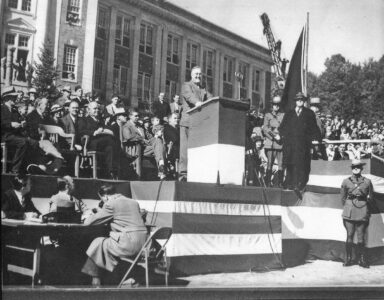Discomfort zone
Deer flies have speeds up to 25 miles an hour. And despite my best efforts, I wasn’t pedaling that fast on my mountain bike, the day hubby Bill and I rode into Camp Santanoni. It’s been a hot, humid summer, so those little buggers have flourished. That the five-mile road to the camp was uphill both ways didn’t help matters. And, if you have ever tried to squash a biting bug through the vents of a bike helmet as sweat dripped down your forehead, you can appreciate my situation. In this case, vexation was motivation; while some deer flies were fast, not all of them were committed to racing. So, the quicker I pedaled, the less of a feast I became.
Camp Santanoni is one of the oldest Great Camps in the Adirondacks, and it has been preserved, not restored. This means that it is stable but not beautified. Also, unlike other storied structures, it was never ornate — it was meant to be a Japanese-inspired woodland retreat. Mostly completed by 1893, Robert Pruyn, a banker, pictured it as the equivalent of a British country estate. Anna, his wife, a true outdoorswoman, saw it as a wilderness escape.
The reward of our bike trip, besides some itchy welts, was the tour. The payoff began as we sat on the massive porch, designed to catch a shady breeze, keeping its occupants cool and bug-free on a hot summer day. An interpreter led the tour itself, shedding light on what might otherwise seem like empty rooms. My favorite fun facts? The indoor communal room was purposefully dark and rather small. Why? To force people to be outside. And the beds in the guest rooms were intentionally uncomfortable. Why? To encourage people to wake up and go outside. The Pruyns knew that a little discomfort could produce a whole lot of get-up-and-go. They wanted their family and guests to immerse themselves in and enjoy nature as much as they did.
My father would have approved of their methods. He was no stranger to using nuisance as an inducement. Saturday mornings, there was no sleeping in. If the sun was up, his kids should be too. The Eddie Arnold 8-track cassette would go into the malfunctioning player, and the volume would be set on high. The first program of four songs would play, but then repeat continuously. By the time “What’s He Doin’ in My World?” played for the fifth time, everyone was out of bed, unable to take the thunderous crooning any longer.
Planned discomfort apparently is a business model as well. McDonald’s legendary “15-minute chairs” are designed to look bright and inviting, but become uncomfortable after a short time. The payoff comes in the form of higher revenue due to the frequent turnover of customers. Studies show the modern McDonald’s customer spends about 20 minutes per visit, while 45 minutes was typical in the 1970s. This shift is largely attributed to the change in seating.
This shouldn’t be surprising. Let’s face it — a comfortable seat can make you lethargic. It’s kind of the opposite of discomfort as motivation.
During our last move, my sister-in-law Patricia insisted, “Move the couch in last!”
“Why?” I asked. I was sure it had something to do with arranging furniture properly. Feng Shui, or something like that.
“Because once you bring the couch in, my brother will lie down and nothing will get done!”
Patricia may have been teasing, but now that Bill and I are both retired, we worry about becoming couch potatoes. At night, we talk about going out, but our wonderfully cozy sectional drains all initiative from our bodies. It is too easy to curl up in the living room, reading books or watching a ball game. We both know that we need to perform couch-ectomies, but it’s tough separating ourselves from cozy relaxation to go out and socialize a bit more.
Maybe I already know the answer: remove the soft seating, install some fast-food-style booths, and play Eddie Arnold on the smart speaker. Maybe then we would leave the cozy nest. Maybe then our discomfort would turn into ambition. Then again, I could just sit back, get comfy, and think about it.


